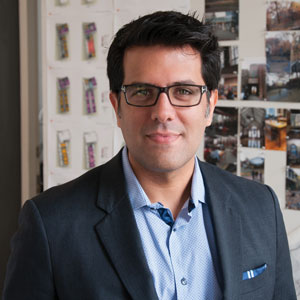The architectural firm of FXFOWLE is never exactly revolutionary in its aesthetic inventions, but it nevertheless usually succeeds in coming up with thoughtful and arresting forms that add something to the urban fabric of the city.
A case in point is the 35-story luxury rental at 44-28 Purves Street in Long Island City, being developed by Brause Realty and the Gotham Organization.
The entire building is punctiliously right-angled, without so much as the intimation of a curve or inflection across its entire surface, and surely with none of the deconstructivist mayhem favored by so many projects in the five boroughs over the last few years.
In the past, when this firm flirted with the deconstructivist style, for example in a building like 11 Times Square at the corner of 42nd Street and Eighth Avenue, the results were a bit weak, given their derivative nature.
Their most recent design in Long Island City, by contrast, has been conceived in a robustly neo-modernist style, and the results promise to be far more satisfying. This is provided, of course, that the building can avoid that sense of value engineering that greatly qualifies the success of 11 Times Square.
The Purves Street project is being built in a part of the city that is exploding with high-rise development. For instance, the Rabsky Group is developing a 25-story tower directly across the street at 44-41 Purves Street.
Still, the FXFOWLE project, at 386 feet tall, will surely be one of the biggest. The 266,000-square-foot building will contain 270 units, consisting of studios, one- and two-bedroom apartments, as well as a one-bedroom penthouse looking out over an expansive private terrace.
In addition, it will offer 26,300 square feet of the sort of sundry amenities that are now standard in so many new developments: a communal living room and outdoor screening area, sky lounge, area for private parties and roof deck with swimming pool, in addition to another swimming pool on the second floor. There will also be 2,600 square feet of ground-floor retail, along with a two-story retail space connected to the building through an amenity-filled second-floor courtyard.

Gustavo Rodriguez
If the renderings are to be trusted in reflecting the ultimate look of the finished tower, then Long Island City stands to add some architectural elegance to its skyline. The project, credited to Gustavo Rodriguez, senior designer, seems as if it has been confected out of three slender structures, wafer-like buildings set side by side, while a fourth, far shorter, crouches at the foot of the other three along their eastern façade. Though it’s unclear whether there’s actually a functional benefit to this design strategy, it certainly looks good, and that in itself is surely sufficient justification.
In this respect, one of the manifest inspirations for the new development is Helmut Hentrich’s Phoenix-Rheinrohr Building, a monument of the International Style that was completed in Düsseldorf in 1960. Like this German archetype, the new project consists of slab-like structures that are dominated by horizontally articulated curtain-walls and that leave the sides of the slabs conspicuously windowless.
There are differences, of course, between the two buildings. The German building consists of only two parts that are bridged by an interstitial masonry passage, whereas the four components of the Purves Street tower are set cheek-by-jowl. And there is that indefinable post-war massiveness in the earlier project, which looks like twinned Kubrickian monoliths that appear before us in a state of the most sullen seriousness imaginable.
But as befits a post-modern American residential development, rather than a post-war Teutonic corporate headquarters, the mood of the Purves Street development is somewhat more inviting and family friendly. Here the component parts are more slender and winsome. What they lack in high modernist seriousness they make up in a certain need to please. This effect is achieved along the exterior through the ruddy, rust-colored anodized aluminum panel facing of the slabs along the sides, as well as through the use of wood, leather and shining glass accents in the interior spaces.
The developer’s assertion that “the design is inspired by the neighborhood’s original industrial heritage” is difficult to see in the renderings, beyond the modernist influences, which are rooted in the sort of industrial design that once marked the area and whose remnants continue to define it. But it is interesting to note the architect’s decision to apply the typology of a mid-century office tower to the residential market. The message would seem to be that today, residential development not only surpasses all else in the five boroughs, but also cannibalizes the forms of all other areas of development.

David Brause
One truly contextual design element that can indeed claim its roots in the area is the double-height lobby that will reportedly include street art, formerly known as graffiti, that was salvaged from the vacant lot over which the building will soon rise. There was a time when this and similar pictorial interventions in the cityscape were a sign of blight and deviancy. But now through a revolution in taste — enshrined in our galleries and museums — and through the fact that the implicit menace of such acts has largely disappeared, graffiti has been defanged, declawed and reduced to a purely ornamental role.
And yet, there is something striking, surely, about this co-optation of pre-existing street art, and one wonders if it is entirely a good thing. In the most charitable reading, it appears to be homage to the area’s past. But the question remains: Is that past imperiled by this new building and by the others sprouting up in the area? And in any case, it seems certain that the creators of such artistic expression are precisely the people who are most apt to feel excluded from these quickly rising
developments.
This use of graffiti is in line with 5Pointz, at 22-24 Jackson Avenue, also in Long Island City. There, the Wolkoff Group is replacing the infamous building that was entirely overrun with graffiti with twin residential high rises, but promises to incorporate walls for street artists to paint in the final project.
Ultimately, the integration of street art into the fabric of any project serves mainly to draw attention to that relentless and irresistible process by which change occurs in New York City, taking all before it.

